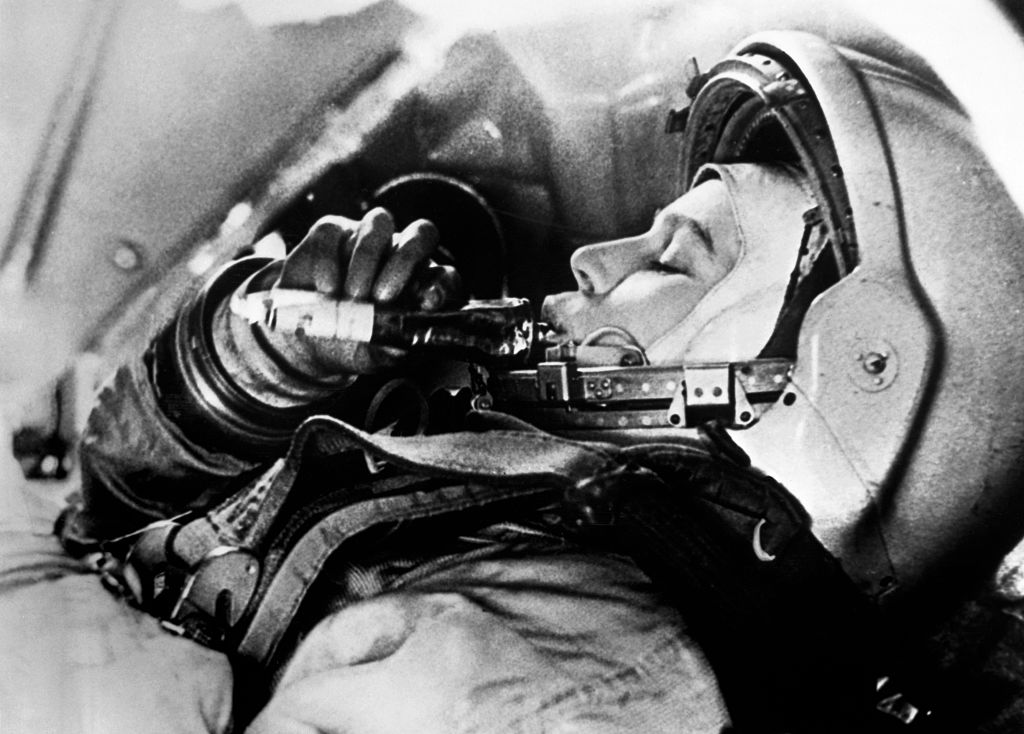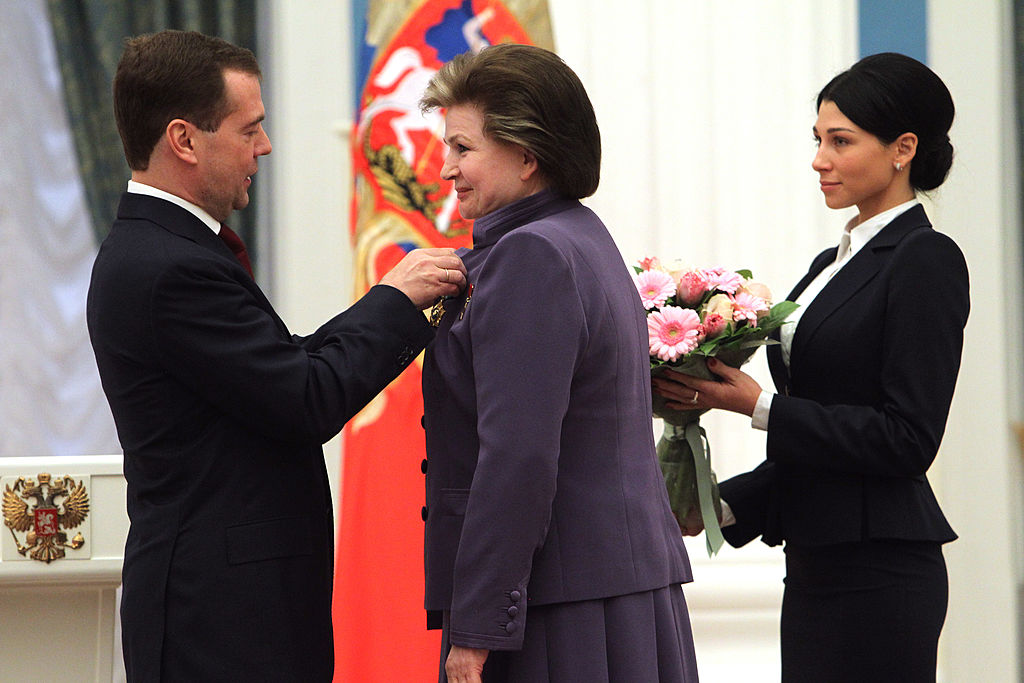Valentina Tereshkova: First woman in space
In 1963 Valentina Tereshkova became the first woman to journey to space orbiting Earth in the Vostok 6 space capsule.

Valentina Tereshkova became the first woman to travel to space on June 16, 1963, when she orbited Earth as part of the Vostok 6 mission.
Tereshkova spent almost three days in space during her solo mission.
She remains the youngest woman to fly to space, the only female astronaut or cosmonaut to make a solo space journey, and the first civilian to journey to space.
Following her one and only space mission, Tereshkova has received a number of prestigious medals and has held many political positions, according to the Royal Museum of Greenwich. She has also toured the world as an advocate for Soviet science.
Related: 20 trailblazing women in astronomy and astrophysics
Early life and joining the Soviet Space Program
Valentina Tereshkova was born Valentina Vladimirovna Tereshkova to a peasant family in Maslennikovo, Russia, on March 6, 1937, according to History.com. Her father was a tractor driver, while her mother worked in a textile factory, the European Space Agency (ESA) says. During her early years, She received little in the way of formal education, and she went to work in a textile factory at just 18. Her father was killed in World War II.
Tereshkova's life changed course when she was 22 and made her first parachute jump with a local aviation club, the Yaroslavl Air Sports Club. She would go on to make over 150 jumps, according to the Smithsonian Air and Space Museum. Her passion for skydiving brought her to the attention of the Soviet space program.
Breaking space news, the latest updates on rocket launches, skywatching events and more!
In April 1961, the program launched Yuri Gagarin, the first human in space, and Soviet Chief Designer Sergey Korolyov was keen to follow this by flying the first woman to space. According to NASA, in 1962, a Soviet space delegation visited the U.S. and came away with the impression that the country was in the process of selecting female astronauts and that a woman from America would journey to space very soon.
Up until this point, the astronauts and cosmonauts selected by the U.S. and by the Soviet Union had been picked from pools of military jet pilots, but according to NASA in the 1950s and early 1960s, these were exclusively male. On 16 February 1962, five women were selected from 400 applicants to join the cosmonaut corps: Tatyana Kuznetsova, Irina Solovyova, Zhanna Yorkina, Valentina Ponomaryova, and Valentina Tereshkova. The group then spent several months training for space flight, including exposure to near weightlessness, isolation tests, and centrifugal testing. They also underwent pilot training in jet aircraft and made 120 parachute jumps, according to ESA.
Four of the candidates passed examinations in Nov. 1962 and were commissioned as lieutenants in the Soviet Air Force. This was just an honorary rank which means Tereshkova was a civilian when she journeyed to space.
At the time, cosmonauts had to parachute from their capsules seconds before they hit the ground on returning to Earth. This was considered one of the most challenging aspects of the Vostok series of missions. It was believed that Tereshkova's experience skydiving would be favorable for this element of the mission. NASA suggests that the other potential female cosmonauts were more technically qualified than Tereshkova, but she better fit the image of a Soviet proletariat and thus made a better political candidate. The space race, was, after all, a political game, with much of the Soviet Union's reason for sending a woman to space rooted in in the desire to do this before the U.S. just had the Soviets had done with Gargarin.
The Soviet Union initially intended to launch two woman cosmonauts into space in late 1962, but the missions were delayed. In March 1963, it was decided that male cosmonaut, Valeri Bykovsky would fly Vostok 5, a separate spacecraft but part of the same dual flight mission as the Vostok 6 capsule, which would be crewed by Tereshkova. Her radio call sign on the mission would be 'Chaika' or 'seagull.'
The Vostok 6 mission
Vostok 5 and Bykovsky launched ahead of Vostok 6 on June 14, 1963, with Tereshkova watching on as she made final preparations for the launch of Vostok 6. Vostok 6 would blast off two days later on June 16, 1963, from Baikonur Cosmodrome.
Vostok 6 was guided by an automatic control system, so Tereshkova never actually took control of the craft during the flight. Though Vostok 5 and 6 had different orbits, they came within around 3 miles of each other during their respective flights. This allowed Tereshkova and Bykovsky to communicate briefly with each other before they drifted apart again.
During the flight of Vostok 6, Tereshkova would also communicate with Soviet leader Nikita Khrushchev, by radio, and her image was televised and broadcast across the Soviet Union. Tereshkova kept detailed logs of the mission and collected data regarding her body's reaction to spaceflight. In addition to this, the first female cosmonaut captured images of Earth, some of which would later be used to identify aerosol layers in our planet's atmosphere.
The Vostok 6 mission lasted 71 hours and 12 minutes, just 48 minutes short of three days. At the time, that was longer than the combined flight time of every U.S. Mercury astronaut. During those three days in space, Tereshkova made 48 orbits of Earth.
On June 19, 1963, Vostok 6 re-entered Earth's atmosphere, and Tereshkova ejected at an altitude of 20,000 feet and parachuted safely back to Earth. Vostok 5 would safely return to Earth just a few hours later.
Tereshkova never returned to space. The female cosmonaut group was disbanded in Oct. 1969, and it would take the Soviet Union another 19 years to send a female cosmonaut to space. In 1982, Svetlana Savitskaya became the second Russian woman in space.
After space: Personal life and politics
Following her return to Earth, Tereshkova was awarded the Order of Lenin and the Hero of the Soviet Union awards. In Nov. 1963, she married fellow cosmonaut Andrian Nikolayev, the pair had a daughter in 1964.
Together Tereshkova and Nikolayev made various trips abroad to promote goodwill and Soviet science. They separated in 1979, but their divorce was only formalized in 1982 as it required the personal permission of Soviet Premier Brezhnev.
During reviews to return to space in 1978, Tereshkova met a military medical physician called Yuliy Shaposhnikov. Following her separation from Nikolayev, Tereshkova, and Shaposhnikov lived together for 20 years until his death in 1999.
Before the fall of the Soviet Union, Tereshkova was a prominent member of the Communist Party and represented the Soviet government at a number of meetings of international women's organizations, including acting as Soviet representative to the UN Conference for the International Women's Year in Mexico City in 1975. She would be recognized internationally with the United Nations Gold Medal of Peace, the Simba International Women's Movement Award, and the Joliot-Curie Gold Medal.
Tereshkova became a member of the World Peace Council in 1966. She served as a member of the Yaroslavl Supreme Soviet in 1967 and as a member of the council of the Union of the Supreme Soviet from 1966 to 1970 and then again from 1970 to 1974 when Tereshkova was elected to the presidium of the Supreme Soviet. In 1977 she earned a doctorate in aeronautical engineering.
During the 1980s, Tereshkova acted as Deputy to the Supreme Soviet and was Vice President of the International Women's Federation, as well as holding a number of other international positions. Tereshkova remained active in politics after the dissolution of the Soviet Union in 1991. Her last political position to date was as Deputy Chair for the Committee for International Affairs in 2021.
Valentina Tereshkova FAQs
How old was Valentina Tereshkova when she went to space?
Tereshkova was just 26 when she flew into space. She remains the youngest woman to make such a journey.
What are three interesting facts about Valentina Tereshkova?
1. Tereshkova married fellow cosmonaut and Vostok 3 crew member Andriyan Nikolayev in November 1963.
2. The daughter of Tereshkova and Nikolayev, Yelena, was born in June 1964 and was the firstborn to two parents who had journeyed to space.
3. Even at 86 years old, Tereshkova wants to be the first woman to travel to Mars, even if this is a one-way trip, according to NASA.
What happened to Valentina Tereshkova after the mission to space?
After her journey to space and before the collapse of the Soviet Union, Tereshkova was an official head of State and has held several political positions since, including Deputy Chair for the Committee for International Affairs in Russia. She was elected as a member of the World Peace Council in 1966.
Famous quotes
"A bird cannot fly with one wing only. Human spaceflight cannot develop any further without the active participation of women."
"If women can be railroad workers in Russia, why can't they fly in space?"
"Once you've been in space, you appreciate how small and fragile the Earth is."
"Anyone who has spent any time in space will love it for the rest of their lives. I achieved my childhood dream of the sky."
"They forbade me from flying, despite all my protests and arguments. After being once in space, I was keen to go back there. But it didn't happen."
Additional resources
Read more about the Vostok 6 spacecraft that carried Tereshkova to space in these NASA resources. The often strange story of the Soviet Space Program is told here in this YouTube video. The first U.S. woman to make it to space was Sally Ride. You can read more about her and her mission courtesy of NASA.
Bibliography
Valentina Tereshkova and Sally Ride - Women Space Pioneers, NASA, [Accessed 06/10/23], [https://www.nasa.gov/mediacast/valentina-tereshkova-and-sally-ride-women-space-pioneers]
Who was the first woman in space? Royal Observatory Greenwich, [Accessed 06/10/23], [https://www.rmg.co.uk/stories/topics/who-was-first-woman-space]
First woman in space: Valentina, ESA [Accessed 06/10/23], [https://www.esa.int/About_Us/ESA_history/50_years_of_humans_in_space/First_woman_in_space_Valentina]
Soviet cosmonaut Valentina Tereshkova becomes the first woman in space, History. Com. [Accessed 06/10/23], [https://www.history.com/this-day-in-history/first-woman-in-space]
Valentina Tereshkova, Britannica, [Accessed 06/10/23], [https://www.britannica.com/biography/Valentina-Tereshkova]

Robert Lea is a science journalist in the U.K. whose articles have been published in Physics World, New Scientist, Astronomy Magazine, All About Space, Newsweek and ZME Science. He also writes about science communication for Elsevier and the European Journal of Physics. Rob holds a bachelor of science degree in physics and astronomy from the U.K.’s Open University. Follow him on Twitter @sciencef1rst.




